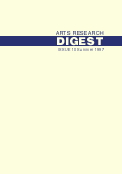
CATEGORY:
MUSEUMS AND HERITAGE
TITLE OF RESEARCH
Collaboration Between Museums: A report for the Museums & Galleries Commission
COMMISSIONED BY
Museums & Galleries Commission
Author(s)
Kate Arnold-Forster, Stuart Davies
(1998) London: Museums and Galleries Commission, 122 pages, ISBN 0 948630 66 3, £16.00
ARTS RESEARCH DIGEST
Collaboration Between Museums: A report for the Museums & Galleries Commission
OBJECTIVES
To provide an up-to-date picture of the ways in which museums collaborate and work together.
METHODOLOGY
Literature review; consultation through individual visits, interviews and by informal discussion; production and dissemination of questionnaire; selected case studies of nine museums. CONTENTS
Executive summary; Introduction; The culture of collaboration; Collaboration reviewed; National and non-national museums; Local authority museums and services; Museums agencies; International museum collaborations; Conclusions: Report fundings assessed against key issues of the study brief; The future of collaboration; Recommendations; Appendices.
SUMMARY
The report found that a substantial majority of those who responded to the survey were involved in one or more collaborations. Loans and exhibitions, and the exchange of advice are amongst the most popular and successful types. A range of agencies that support museums rely to some extent on collaborative strategies. Collaboration provides a mechanism for limited resources to be shared more equably between museums and allows museums to participate in meeting the wider or shared objectives of external bodies. Much of the most successful evidence of museum collaboration is quite often modest in scale and funding but there is an increasing tendency for collaboration with outside funding bodies to involve large budgets and may involve arrangements to collaborate with non-museum organisations. Collaboration has been confined mostly to `traditional' areas. It concludes that collaboration has already proved its value but it still has much more to offer. The areas where most collaboration takes place at present are: loans, temporary exhibitions, archaeological projects, informal information networks and local marketing initiatives. Potential areas for future collaboration are: commercial activities; joint services; collection co-ordination; museum/non-museum collaboration; `super' collaborations; specialist collection collaborations; staff and expertise; sharing of skills; touring, exhibitions and loans; and collection management. Detailed survey findings are presented.
Museums and Galleries Commission, 16 Queen Anne's Gate, London SW1H 9AA Tel: 44(0)171 233 4200 Fax: 44(0) 171 233 3686